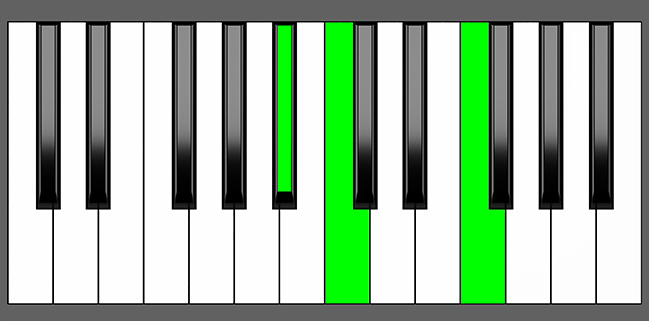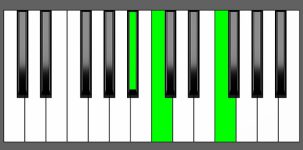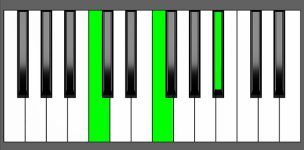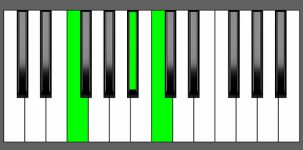Piano Diagram of A#sus2 in Root Position

The A#sus2 chord is comprised of three notes: A#, B#, and E#. This chord is known as a suspended second chord, where the third note of the chord is replaced by a major second. To play the A#sus2 chord on a piano, simply replace the third note of an A# major chord with a major second. Keep reading to get a better grip on the music theory behind this chord.
Structure of A#sus2
Notes |
|---|
| A#, B#, E# |
Intervals |
|---|
| R, 2, 5 |
Fingers Position
Left Hand |
|---|
| 3, 2, 1
4, 2, 1 |
Right Hand |
|---|
| 1, 2, 4
1, 2, 5 |
A#sus2 Chord Inversions
The A#sus2 chord has a total of 2 inversions:
| Root Position: | A# | B# | E# |
| 1st Inversion: | B# | E# | A# |
| 2nd Inversion: | E# | A# | B# |
Piano Keyboard Diagrams
A#sus2 Chord Equivalencies
An interesting detail about sus2 chords is that their 2nd inversion results in a sus4 chord. To clarify, when the 5th note of a sus2 chord becomes the root note, it transforms into a sus4 chord.
2nd Inversion of A#sus2 = Fsus4 (E#sus4)
For instance, if we take the A#sus2 chord with the notes A#, B#, and E# and rearrange them so that E# becomes the root note, we end up with an E#sus4 chord with the notes E#, A#, and B# (which is equivalent to Fsus4). Therefore, the 2nd inversion of A#sus2 is equivalent to Fsus4.
Music Theory and Harmony of A#sus2
What are Suspended Chords?
In suspended chords, the third note is replaced by either a major second or a perfect fourth. The resulting chords are called suspended second (sus2) or suspended fourth (sus4) chords, respectively. These chords create a unique and sometimes unresolved sound that can add tension and interest to a musical composition.
Suspended chords have a distinctive sound that sets them apart from major and minor chords. They are so-called because they temporarily suspend the listener’s expectation of hearing a major or minor stable chord. Instead, they feature a perfect fourth or major second interval in place of the third. Due to their “neutral nature”, suspended chords can sometimes be used as substitutes for both, major and minor chords.
Building the A#sus2 Chord: Different Approaches
Starting from the A# major Scale
To build a sus2 chord, you can use the major scale as a guide and combine a root note, a major 2nd interval, and a perfect 5th interval.


To create an A#sus2 chord, apply the formula R, 2, 5 in the following manner:
- Begin with the Root note, which is A#.
- Select the major 2nd interval, which is B#, and add it to the chord.
- Finally, add the 5th interval, which is E# (F).
By following this simple formula, you can create a sus2 chord from any major scale.
by Combining Intervals
One method to create a suspended 2nd chord is by combining two specific intervals – a major 2nd, and a perfect 4th.
2 + 4 = sus2 Chords
To illustrate, let’s use the A#sus2 chord as an example. By examining the intervals between the notes, we can see that A#-B# forms a major 2nd interval, and B#-E# (C-F) creates a perfect 4th interval.
How to Use A#sus2 in a Chord Progression
Suspended second (sus2) chords are neither major nor minor, making them a great option to create tension and suspense before resolving to major and minor chords.
The tables below show the harmonization of major and relative natural minor scales for keys that include A# major (including A#7 chords) and A# minor chords in various positions and different harmonic roles.
A# major is a theoretical key with 10 sharps (three double sharps and four single sharps), making it impractical to use due to the high number of accidentals. Musicians often use its enharmonic equivalent, Bb major, which has only two flats. This applies to other keys with an A# major chord, such as E# and D# major, as well as all minor keys (Fx, Cx, and B#). Therefore, it is more practical to refer to the equivalent chord, Bbsus2.
A#sus2 as Substitute of A# Maj Chords
on Major Scales
| Major Scales | I | ii | iii | IV | V | vi | vii |
|---|---|---|---|---|---|---|---|
| A# = Bb | Bb Maj7 ⇒ Bbsus2 = A#sus2 | C min7 | D min7 | Eb Maj7 | F Maj7 | G min7 | Am7b5 |
| E# = F | F Maj7 | G min7 | A min7 | Bb Maj7 ⇒ Bbsus2 = A#sus2 | C Maj7 | D min7 | Em7b5 |
| D# = Eb | Eb Maj7 | F min7 | G min7 | Ab Maj7 | Bb7 ⇒ Bbsus2 = A#sus2 | C min7 | Dm7b5 |
- Tonic chord in Bb Major as Bbsus2
- Subdominant chord in F Major as Bbsus2
- Dominant chord in Eb Major as Bbsus2
on Natural minor Scales
| Minor Scales | i | ii | III | iv | v | VI | VII |
|---|---|---|---|---|---|---|---|
| Fx = G | G min7 | Am7b5 | Bb Maj7 ⇒ Bbsus2 = A#sus2 | C min7 | D min7 | Eb Maj7 | F7 |
| Cx = D | D min7 | Em7b5 | F Maj7 | G min7 | A min7 | Bb Maj7 ⇒ Bbsus2 = A#sus2 | C7 |
| B# = C | C min7 | Dm7b5 | Eb Maj7 | F min7 | G min7 | Ab Maj7 | Bb7 ⇒ Bbsus2 = A#sus2 |
- Mediant chord in G minor as Bbsus2
- Submediant chord in D minor as Bbsus2
- Leading tone chord in C minor as Bbsus2
A#sus2 as Substitute of A# min Chords
In the key of F# Major and D# minor, the note B# can clash with the natural B or the C# notes that are part of those keys. While this doesn’t prevent you from using the A#sus2 chord in those positions, it’s important to be aware that it can create a strong dissonance with the melody or other elements of the composition.
on Major Scales
| Major Scales | I | ii | iii | IV | V | vi | vii |
|---|---|---|---|---|---|---|---|
| G# = Ab | Ab Maj7 | Bbm7 ⇒ Bbsus2 = A#sus2 | C min7 | Db Maj7 | Eb7 | F min7 | Gm7b5 |
| F# | F# Maj7 | G# min7 | A# min7 ⇒ A#sus2 | B Maj7 | C#7 | D# min7 | E#m7b5 |
| C# | C# Maj7 | D# min7 | E# min7 | F# Maj7 | G#7 | A# min7 ⇒ A#sus2 | B#m7b5 |
- Supertonic chord in Ab Major scale as Bbsus2
- Non Diatonic Mediant chord in F# Major scale
- Submediant chord in C# Major scale
on Natural minor Scales
| Minor Scales | i | ii | III | iv | v | VI | VII |
|---|---|---|---|---|---|---|---|
| A# | A# min7 ⇒ A#sus2 | B#m7b5 | C# Maj7 | D# min7 | E# min7 | F# Maj7 | G#7 |
| E# = F | F min7 | Gm7b5 | Ab Maj7 | Bbm7 ⇒ Bbsus2 = A#sus2 | C min7 | Db Maj7 | Eb7 |
| D# | D# min7 | E#m7b5 | F# Maj7 | G# min7 | A# min7 ⇒ A#sus2 | B Maj7 | C#7 |
- Tonic chord in A# minor
- Subdominant chord in F minor as Bbsus2
- Non Diatonic Dominant chord in D# minor
A#sus2 in A# Major
Check Bbsus2 in Bb Major
A#sus2 in E# Major
Check Bbsus2 in F Major
A#sus2 in D# Major
Check Bbsus2 in Eb Major
A#sus2 in Fx Minor
Check Bbsus2 in G minor
A#sus2 in Cx Minor
Check Bbsus2 in G minor
A#sus2 in B# Minor
Check Bbsus2 in C minor
A#sus2 in G# Major
Check Bbsus2 in Ab Major
A#sus2 in F# Major (Non diatonic)
In the key of F# Major, the A#sus2 chord can be used as a non-diatonic substitution for the A# minor chord on the III degree, adding a different tonal color to the progression. However, it is important to be aware that the A#sus2 chord contains a B# that could clash with the natural B or the C-sharp present in the F# Major scale.
| I | ii | iii | IV | V | vi | vii |
| F# Maj7 | G# min7 | A# min7 | B Maj7 | C#7 | D# min7 | E#m7b5 |
A#sus2 Chord Progressions as iii degree
I iii IV V
| I | iii | IV | V |
| F# Maj7 | A#sus2 | A#m7 | B Maj7 | C#7 |
I iii ii V
| I | iii | ii | V |
| F# Maj7 | A#sus2 | A#m7 | G# min7 | C#7 |
I iii vi IV
| I | iii | vi | IV |
| F# Maj7 | A#sus2 | A#m7 | D# min7 | B Maj7 |
A#sus2 in C# Major
Let’s explore how the A#sus2 chord can function as a submediant chord in the key of C# major. You can try incorporating it into chord progressions that feature an A#m chord on the VI degree.
| I | ii | iii | IV | V | vi | vii |
| C# Maj7 | D# min7 | E# min7 | F# Maj7 | G#7 | A# min7 | B#m7b5 |
A#sus2 as vi degree – Chord Progressions
I iii vi V
| I | iii | vi | V |
| C# Maj7 | E# min7 | A#sus2 | A#m7 | G#7 |
I vi ii V
| I | vi | ii | V |
| C# Maj7 | A#sus2 | A#m7 | D# min7 | G#7 |
I IV ii V iii vi ii V
| I | IV | ii | V | iii | vi | ii | V |
| C# Maj7 | F# Maj7 | D# min7 | G#7 | E# min7 | A#sus2 | A#m7 | D# min7 | G#7 |
A#sus2 in A# Minor
When using the A#sus2 chord in the key of A# minor, it can be a variation of the traditional A#m chord. It creates a more ambiguous sound due to its suspended nature, but it can be used to add tension to a chord progression.
| i | ii | III | iv | v | VI | VII |
| A# min7 | B#m7b5 | C# Maj7 | D# min7 | E# min7 | F# Maj7 | G#7 |
A#sus2 Chord Progressions as i degree
i VI VII
| i | VI | VII |
| A#sus2 | A#m7 | F# Maj7 | G#7 |
Chromatic modulation
| i | isus2 | isus4 | i |
| A# min
(A#, C#, E#) |
A#sus2
(A#, B#, E#) |
A#sus4
(A#, D#, E#) |
A# min
(A#, C#, E#) |
i iv VI VII
| i | iv | VI | VII |
| A#sus2 | D# min7 | F# Maj7 | G#7 |
A#sus2 in E# Minor
Check Bbsus2 in F minor
A#sus2 in D# Minor (Non Diatonic)
As an alternative or substitution for the v degree chord (A# minor chord) in the key of D# minor, you may use an A#sus2 chord. However, note that the A#sus2 chord is non-diatonic in this key due to the presence of B#, while the D# minor scale includes a natural B. Therefore, it’s generally advisable to avoid using the A#sus2 chord in this context, but don’t hesitate to experiment and see how it sounds to your liking.
| i | ii | III | iv | v | VI | VII |
| D# min7 | E#m7b5 | F# Maj7 | G# min7 | A# min7 | B Maj7 | C#7 |
A#sus2 as v degree – Chord Progressions
i iv VI v
| i | iv | VI | v |
| D# min7 | G# min7 | B Maj7 | A#sus2 | A#m7 |
i v VI VII
| i | v | VI | VII |
| D# min7 | A#sus2 | A#m7 | B Maj7 | C#7 |
i VI v iv
| i | VI | v | iv |
| D# min7 | B Maj7 | A#sus2 | A#m7 | G# min7 |
Alternative Names for A#sus2 Chord
- A#sus2
- A#sus(2)
- A# add2(no3)
- A# add2(omit3)
- A# suspended 2nd
Conclusion
While the chord progressions and examples in this post offer a comprehensive overview of common uses for the A#sus2 chord, space constraints prevent a full exploration of advanced harmony topics. These include chord progressions based on scales, modal interchange, and jazz harmony. However, readers are encouraged to continue their studies to gain a deeper understanding of the harmonic possibilities beyond the basics presented here.
I hope this post has been informative and helpful in your music theory journey. Keep exploring and creating music, and don’t forget to have some fun along the way!


